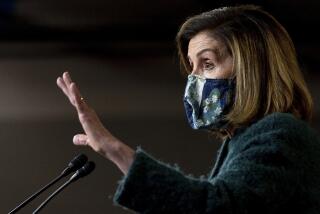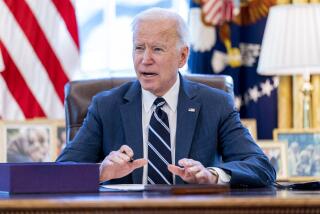Fed chief buys into a new stimulus plan
- Share via
WASHINGTON — The last major obstacles to another government stimulus package began crumbling Monday, shifting the debate from whether the fading economy needs a jolt to the best way of providing it.
Federal Reserve Chairman Ben S. Bernanke endorsed the idea of further stimulus for the first time in congressional testimony Monday. Soon after that, the White House said President Bush was “open to ideas” as long as they were “targeted, temporary and timely.”
Bernanke’s backing of more government stimulus helped stir the stock market. The Dow Jones industrial average closed up about 413 points, or 4.7%, on hopes of more government action and signs that the credit markets were improving.
The new signs of support cheered Democrats, who have been advocating a stimulus package of about $150 billion for several weeks. Their plan would include extending unemployment benefits to several million jobless workers whose federal assistance is coming to an end -- a proposal that appears to have substantial bipartisan support.
Other actions being considered by Democrats are increasing food-stamp benefits and sending extra money to state governments to offset proposed spending cuts that could lead to layoffs of public-sector workers. In addition, Democrats said many already-planned infrastructure projects could be started in 30 to 90 days, providing new jobs for laid-off workers.
Republicans also want to focus on creating jobs but favor stimulating them largely through tax breaks for businesses and consumers. House Minority Leader John A. Boehner (R-Ohio) has suggested temporarily lowering the tax rate for companies that agree to buy distressed financial assets. He also wants to encourage investment by lowering the capital gains tax.
In addition, Republicans have proposed making it easier for companies to start offshore oil drilling to create jobs.
The GOP opposes increasing infrastructure spending, setting up another philosophical showdown over the role of government in aiding the economy. Democrats tend to see infrastructure improvement as an investment in the country’s long-term strength, but Republicans contend that the money would do the economy more good in the form of tax cuts that let the private sector make the spending decisions.
Bush, participating in a meeting on the economy with the Central Louisiana Chamber of Commerce, sounded an optimistic note on the financial crisis.
“I have heard that people’s attitudes are beginning to change, from a period of intense concerns -- and I would call it near-panic -- to being more relaxed and beginning to see the effects of changes and the liquidity that is being pumped in the system,” the president said.
Bernanke did not endorse specific ideas and declined to offer an estimate for the scale of a stimulus package. But his support earlier this year helped pave the way for a $168-billion package that included tax rebate checks for millions of Americans.
“With the economy likely to be weak for several quarters, and with some risk of a protracted slowdown, consideration of a fiscal package by Congress at this juncture seems appropriate,” Bernanke told the House Budget Committee.
House Speaker Nancy Pelosi (D-San Francisco) urged Bush and congressional Republicans “to once again heed Chairman Bernanke’s advice” and work with Democrats “to enact a targeted, timely and fiscally responsible economic recovery and job creation package.”
Adding a jobs component is crucial, given the rising unemployment rate, said Rep. George Miller (D-Martinez), chairman of the House Education and Labor Committee and a close ally of Pelosi’s.
“The rebate made sense then, but there’s a question of whether it makes sense now,” he said. “There’s very real concern that we need to do something now, but it has to be about jobs; it has to be about real investment in the country.”
Republicans also seized on Bernanke’s comments, pointing to his recommendation that a stimulus package should be designed so that its “peak effects” would hit when the economy is weak. At the same time, it should have limited long-term effects on the ballooning federal budget deficit.
“House Republicans agree with Chairman Bernanke that action to strengthen our economy is needed, and it should come in the form of pro-growth policies that create new jobs, lower energy costs and protect taxpayers -- not hundreds of billions in new government spending masquerading as ‘economic stimulus,’ ” Boehner said.
White House spokeswoman Dana Perino told reporters that the president was “open to ideas . . . that would stimulate the economy and help us pull out of this downturn faster.”
As recently as last week, however, the White House expressed opposition to infrastructure spending, saying it would not boost the economy quickly.
In the short term, the administration is focused on implementing the $700-billion rescue package, she said. As part of that, the Treasury Department on Monday began moving to inject $250 billion into U.S. banks. It will begin releasing the funds immediately, officials said.
“This is an investment, not an expenditure, and there is no reason to expect this program will cost taxpayers anything,” Treasury Secretary Henry M. Paulson said.
About $125 billion has been pledged to nine of the nation’s largest financial institutions. The remaining $125 billion is available for banks, savings and loans and other such companies. Candidates must fill out a two-page form, and their financial health must pass muster with federal regulators.
Treasury officials have insisted that the goal of the program is to aid healthy banks, not prop up weak ones. Federal regulators have said that weaker banks may qualify only in the context of a merger with a stronger institution or if they can attract additional capital from private sources at the same time.
Any pending mergers, acquisitions or other plans for raising capital must be disclosed as part of the application, officials said. The deadline to apply is Nov. 14.
“This program is designed to attract broad participation by healthy institutions and to do so in a way that attracts private capital to them as well,” Paulson said. “Our purpose is to increase confidence in our banks and increase the confidence of our banks, so that they will deploy, not hoard, their capital.”
--
Staff writer Richard Simon contributed to this report.
maura.reynolds@latimes.com
--
(BEGIN TEXT OF INFOBOX)
Where the money might go
Among the proposals expected to be considered for a new stimulus package that could cost $150 billion or more:
* Extension of unemployment benefits to those who have exhausted their benefits. Payments would be extended in all states but probably longer in those with high jobless rates.
* Spending for infrastructure such as highway and school construction projects.
* Aid to the states, including help with Medicaid costs.
* Increased food stamp benefits.
More to Read
Get the L.A. Times Politics newsletter
Deeply reported insights into legislation, politics and policy from Sacramento, Washington and beyond. In your inbox twice per week.
You may occasionally receive promotional content from the Los Angeles Times.











